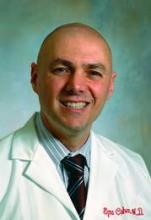There now seems little doubt that clinical outcomes are much better for oropharyngeal cancers that are positive for human papillomavirus.
The question now, experts say, is what to do with that knowledge.
Current therapy for any head and neck cancer is arduous, to put it mildly, said Dr. Ezra Cohen of the University of Chicago. With its intense chemotherapy induction and wide-field radiation, "treatment for locally advanced head and neck cancer is really toxic," he said in an interview. "It’s about 6 months of very intensive treatment and recovery. Many patients require tube feeding and intravenous hydration. This leaves patients susceptible to infections and electrolyte imbalance, and – even though it’s sad to say – some small chance of mortality. It seems theoretically avoidable, but in truth about 1%-2% of patients will die because of treatment-related complications. We accept this, because most of these cancers will be cured, but it does come at a cost."
Patients with HPV-positive cancers may be in a better position to survive – mainly because their tumors seem more susceptible to treatment. But in the future, they also may be spared the intensive therapy that could, in fact, unnecessarily endanger them.
Several large epidemiologic and retrospective studies have confirmed the fact that HPV-positive oropharyngeal cancers are associated with better long-term outcomes than are HPV-negative tumors.
A 2007 analysis presented at the annual meeting of the American Society of Clinical Oncology found that HPV positivity conferred a 79% lower risk of death in the phase II ECOG (Eastern Cooperative Oncology Group) study of taxane-based induction chemotherapy followed by taxane-based concurrent chemoradiation in resectable stage III-IV larynx and oropharyngeal cancer patients.
More recently, investigators from DAHANCA (the Danish Head and Neck Cancer Group) reported that p16 expression – found in HPV-positive tumors – predicted better long-term outcomes for patients with oropharyngeal tumors in an analysis of data from two clinical trials. The analysis, presented at a meeting of the European Society for Therapeutic Radiation and Oncology, followed a pilot study that found p16 expression to be highly correlated with HPV infection in tissue from 32 tonsillar cancers.
These findings beg the question: Would HPV-positive tumors respond just as well to less-intense therapies, which could mean less danger for patients and certainly less discomfort and lower anxiety?
Two experts who were interviewed for this article agreed that more data are necessary to make an overall recommendation.
"This is a really exciting time in head and neck cancer," said Dr. Neil Hayes of the University of North Carolina at Chapel Hill. "We are on the verge of a transformation as to how we understand and treat these cancers, but are not quite there yet. With any major change in therapy or understanding of disease, there is a major transitional period in how we assess and treat it. With aggressive therapy, we are doing very well. We have not seen any large prospective studies that give us clear information that we can back off on the therapy."
Additionally, Dr. Hayes said, retrospective studies can all suffer from biases that slant the results, including potentially important risk factors like smoking. "It’s clear that smoking affects the risk in these tumors, but we don’t understand the biology of just how it does this. And partially because of this, it’s hard to say we really understand how HPV modifies the risk of the cancers, and how it does in relation to smoking."
There can be no question, however, that these decisions will need to be made, and soon. Epidemiologic studies from Scandinavia and Eastern Europe confirm that HPV-associated oropharyngeal cancer is rising at an alarming rate. "The data are real," Dr. Hayes said. "We are seeing a pandemic of HPV-associated tumors."
Again, the whys and wherefores remain unclear, said Dr. Cohen. "There has been a dramatic rise in our own country [and] in Canada, Scandinavia, and Western European countries over the past 3 decades. What’s really scary is, when you look at the curve, you can see that it is not flattening at all; it continues to rise more acutely, suggesting that we are at the beginning of this epidemic and it’s going to become even more common over the next decade or two."
Some researchers posit that the increase has a direct connection to a change in sexual practices – particularly an increase in oral sex, perhaps as people try to avoid other sexually transmitted diseases. "That’s not definitive, but it probably is true that sexual practices are changing during the last century. But there are some holes in that theory," Dr. Cohen said. "Data are emerging that there may be racial differences in HPV. Blacks seem to have a much lower incidence of the HPV-positive oropharyngeal tumors than whites. But the epidemiologic data don’t support the idea that there are differences in sexual practices. Again, there is so much we don’t know."


